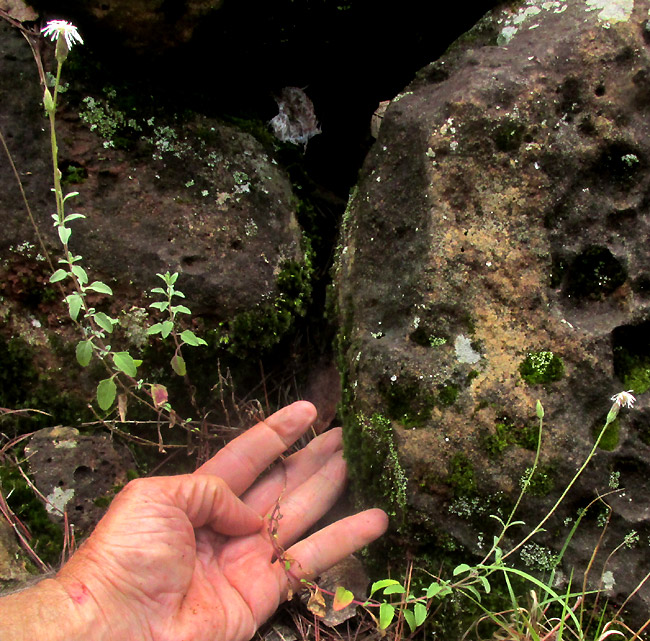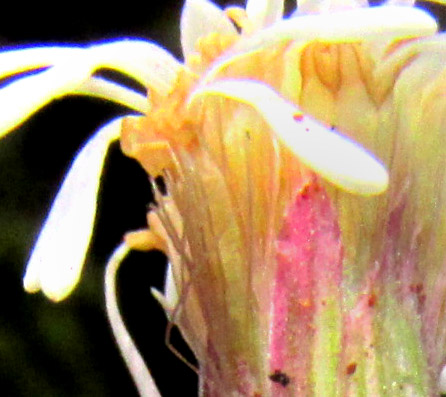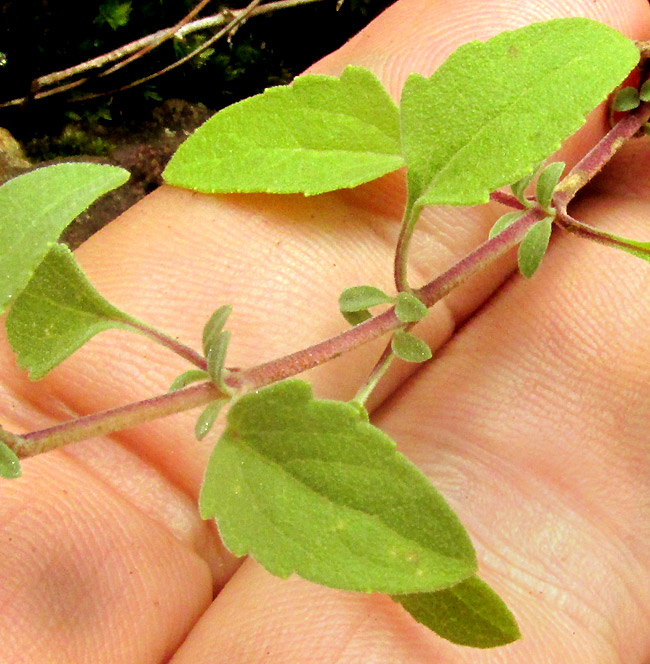Excerpts from Jim Conrad's
Naturalist Newsletter
Entry dated November 11, 2023, from notes taken on slope earlier very eroded with deep gullies in compacted volcanic ash, or tuff, now reforested with pines about 15 years old; 1.5km SW of community of San Pablo, municipality of Almeaco de Bonfil; N20.0785°, W99.9941°, elevation 2600 meters (8530 feet); extreme southern Querétaro state, MÉXICO
BRICKELLIA PEDUNCULOSA

The above wildflower whose slender stems tended to recline atop the ground, grew at the base of two split basaltic boulders.

A flowering head viewed from above revealed that what had seemed to be white petals or ray florets, in fact, were remarkably long, flat style branches, each pair emerging from atop an ovary at the bottom of each of several cylindrical, five-lobed, disk-floret corolla tubes. At the flowering head's periphery, style branches of earlier-opening florets were much longer than those of florets in the head's center. Inside each corolla tube, just below its lobes, it was yellowish. Florets grouped in such heads indicated that this was yet another species of the largest and most diverse of all plant families, the Composite/Aster/Sunflower Family, the Asteraceae.

The green and reddish-purple involucre enveloping the corolla tubes was composed of scale-like phyllaries of different lengths, some more diffused with the reddish hue than others. Phyllaries and the peduncle were densely covered with glands and hairs.

The close-up at the right shows slender, white hairs or bristles of an ovary's pappus. Knowing what kind of pappus, if any, the ovaries produce is critically important for Aster Family identification. Also often it's necessary to know whether between floret bases there are scale-like paleae. However, our plant, the only one in the area, bore only two flowering heads and I didn't want to destroy them in order to gain this information.

Oval leaves with bases gradually narrowing to slender petioles arose in pairs opposite one another. The stems were pink, and the pinkness diffused into the petioles. Leaf blades were oval, with two or three low teeth at their bases.

Above, both short hairs and what appears to be abundant glands are seen. However, without greater magnification and clarity it's hard to say whether the hairs are what people think of as glandular.
The 2010 digital edition of the Flora fanerogámica del Valle de México, treats flowering plants in Mexico's Central Valley. Surely it considers at least 95% of the species occurring here in extreme southern Querétaro's mountains identifies, and it led me to Eupatorium longipes. However, Kew's Plants of the World Online database lists that name as a synonym for BRICKELLIA PEDUNCULOSA. Expert-identified images of that species appear to match our plant perfectly. The species is known by no English name, though all species of Brickellia can be called brickellbushes.
Brickellia pedunculosa is described as endemic just to oak and pine forests from northeastern Mexico south to Michoacán and the Mexican Central Valley. It appears to be seldom collected, and little literature deals with it comprehensively, except for the 1967 study by P.A. Harcombe and J.H. Beaman entitled "Transfer of Two Mexican Species from Eupatorium to Brickellia (Compositae)." In that work, Brickellia pedunculosa is considered to be a relatively primitive member of the genus Brickellia, based on the size of its nine chromosomes, its producing one flowering head per stem, having relatively many florets per head, and its developing relatively long cypsela-type fruits.
Probably because it's such an unnoticed species, I find no literature about its human uses. It's just another obscure species of limited distribution contributing its share to the integrity of the entire biosphere, and providing a pleasure to any sentient being pausing to admire it being itself.